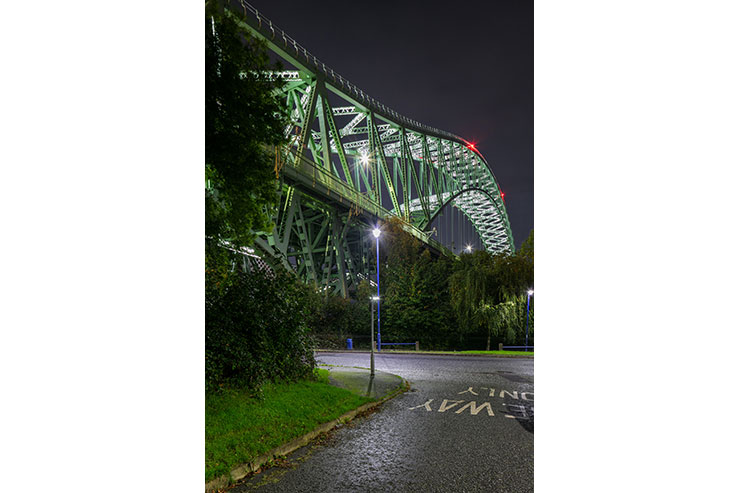- ABOUT
- JUDGING
- CONTACT
- MORE
- 2024 Entries
- Installations 2024
- Past Winners
- Subscribe
- [d]arc directory
- arc magazine
- darc magazine
Silver Jubilee Bridge, UK
ProjectSilver Jubilee BridgeLocationRuncorn and Widnes, UKLighting DesignArup, UKAdditional DesignMain Contractor: Balvac | Lighting Installation and Controls Programming: StudioTech UKClientHalton Borough CouncilLighting SuppliersGriven, e:cuePhotographyMidi Photography
The Silver Jubilee Bridge crosses the River Mersey and the Manchester Ship Canal between Runcorn and Widnes. At the request of Halton Borough Council, Arup developed a lighting concept with the aim of celebrating the intricate beauty of the structure, with its graceful form that swoops high over the river.
Lighting is a tool for placemaking, an opportunity to reinstate landmarks and an educational palette for observers. When working with heritage landmarks, our lighting designers think beyond their title to take on the role of a historian and storyteller, and also think about the importance of our cultural landscape for those who live alongside. Our ambitions for the scheme were to reflect the history and structural features of the bridge, reduce obtrusive light, and reinforce the identify of this Grade II listed structure against the contrasting and modern Mersey Gateway Bridge upstream.
The previous lighting scheme flooded the bridge with cold white light, flattening the architectural details and contributing significantly to light pollution above the neighbouring towns and on the sensitive marine environment on the estuary. Finding an alternative to these characteristics became a key objective of our design concept.
Arup began the design process with a survey, gathering measurements and photographs to characterise the nocturnal scene, followed by research into the site, context and history of the bridge and its construction. The location of the bridge, high above the neighbouring towns of Runcorn and Widnes has made it a prominent feature for generations.
The lighting concept is based around illumination of the two arched planes comprising the lower and upper chords of the bridge arch. The chords are cross-braced with lattice girders and narrow beam luminaires are concealed within. Our research concluded that the lack of local lighting competition allowed much subtler lighting techniques to be used, and that luminaires could be discretely concealed within the structure rather than distract from the architecture.
On closer inspection, this technique of ‘lighting from within’ reveals lots of the fine detail of the bridge structure, telling the story of its construction from the foundations to the apex, highlighting the textures, and revealing the labour behind every rivet and metal plate which binds the structure together. From further afield the magnificence of the arch is clearly defined by lighting which offers an alternative perspective to the daytime view.
The concept was also driven by our passion to reduce obtrusive light and its negative impacts on biodiversity and the nocturnal environment. Locating luminaires close to the structure, rather than projecting light as per the original scheme, meant the efficiency was radically improved. Energy savings exceeding 95% and an equivalent reduction in light spill into the night sky have been achieved in comparison.
For most of the year, the elegant white lighting is displayed statically across the bridge, but it can also display dynamic colour. Arup curated a programme of five-minute light shows which play at intervals throughout the evenings, around key celebrations and national events such as New Year, Pride and Remembrance. The bridge is a well-loved landmark for the community and in recognition of this, Arup is also engaging with primary school children at Widnes Academy to create a light show uniquely for them, which will be displayed early in 2024.









